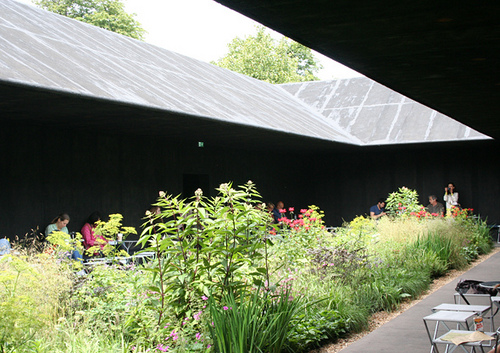Serpentine Gallery Pavilion 2011




 (be the first to vote by clicking on the stars)
(be the first to vote by clicking on the stars)Location:
Outside the Serpentine Gallery
Royal Park of Kensington Gardens
London
United Kingdom
coordinates: 51.5046806,-0.1750088
open coordinates in google maps
open coordinates in apple map
Building names(s): Serpentine Gallery Pavilion 2011
Architect/Designer: Peter Zumthor
more images:
Completion date: 1 July - 16 October 2011
function(s): pavilion
credentials/awards: 2011 August BOM, BOM, Sepentine Gallery Pavilion
getting there: Nearest Tube: South Kensington or Lancaster Gate opening hours: Gallery open 10am to 6pm daily. gallery website: www.serpentinegallery.org design concept: The concept for this year’s Pavilion is the hortus conclusus, a contemplative room, a garden within a garden. One enters the building from the lawn and begins the transition into the central garden, a place abstracted from the world of noise and traffic and the smells of London – an interior space within which to sit, to walk, to observe the flowers. With this Pavilion, as with previous structures such as the famous Thermal Baths at Vals, Switzerland, or the Bruder Klaus Chapel in Mechernich, Germany, Zumthor has emphasised the sensory and spiritual aspects of the architectural experience, from the precise yet simple composition and ‘presence’ of the materials, to the handling of scale and the effect of light. At the heart of Peter Zumthor’s practice is a refined selection of materials used to create contemplative spaces that evoke the spiritual dimension of our physical environment. As always, Zumthor’s aesthetic goal is to customise the building precisely to its purpose as a physical body and an object of emotional experience. Hortus conclusus 'A garden is the most intimate landscape ensemble I know of. It is close to us. There we cultivate the plants we need. A garden requires care and protection. And so we encircle it, we defend it and fend for it. We give it shelter. The garden turns into a place. Enclosed gardens fascinate me. A forerunner of this fascination is my love of the fenced vegetable gardens on farms in the Alps, where farmers’ wives often planted flowers as well. I love the image of these small rectangles cut out of vast alpine meadows, the fence keeping the animals out. There is something else that strikes me in this image of a garden fenced off within the larger landscape around it: something small has found sanctuary within something big. The hortus conclusus that I dream of is enclosed all around and open to the sky. Every time I imagine a garden in an architectural setting, it turns into a magical place. I think of gardens that I have seen, that I believe I have seen, that I long to see, surrounded by simple walls, columns, arcades or the façades of buildings – sheltered places of great intimacy where I want to stay for a long time.'
updated on: 25 August 2011 | suggested on: 4 July 2011 |
Suggested By LT
